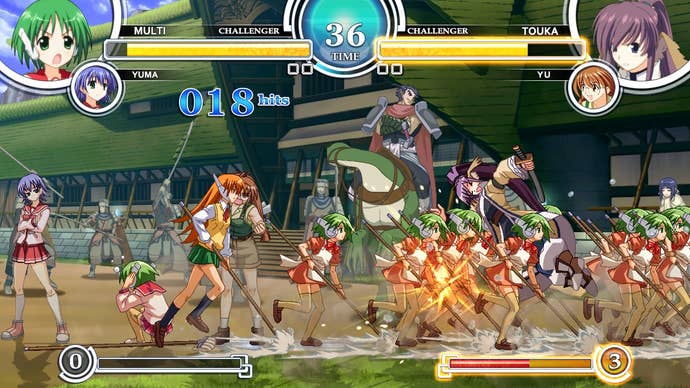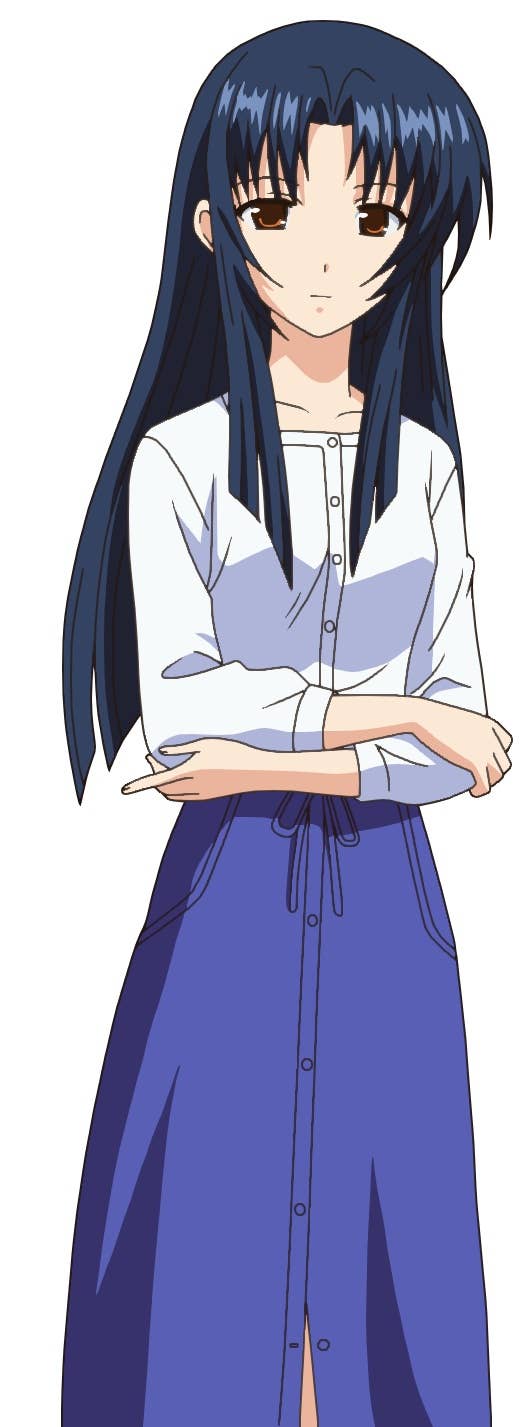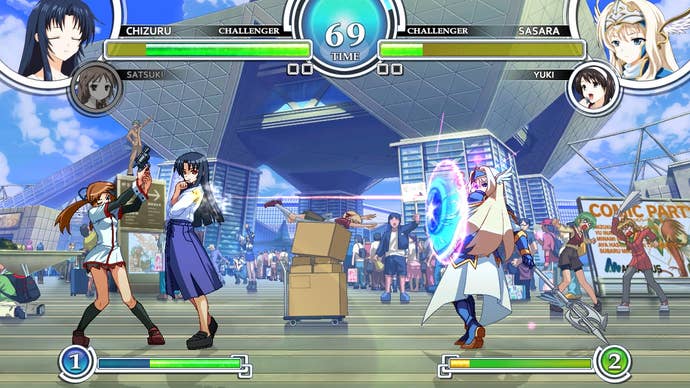AquaPazza PS3 Review: Battling with the Power of Moe
Atlus brings us a fighting game based on a series of visual novels from Aquaplus' Leaf label, in the process creating possibly the most specialized, niche game of all time. Is it a dream match or a fighting game nightmare?
This article first appeared on USgamer, a partner publication of VG247. Some content, such as this article, has been migrated to VG247 for posterity after USgamer's closure - but it has not been edited or further vetted by the VG247 team.
AquaPazza is a brave game, and I have to respect Atlus for releasing it in the West, because it feels like a product tailor-made to a very specific -- and very small -- audience.
This issue is somewhat less of an problem in the game's native Japan, where developer Aquaplus and its Leaf label are established names in all-ages visual novels and adults-only eroge respectively, but here in the West our sole exposure to the work of Aquaplus and Leaf -- officially, anyway -- is through localized anime and manga adaptations of its more popular titles such as To Heart, Utawarerumono, Comic Party and Tears to Tiara.
So who is this game for? Well, the way I see it, there's three distinct groups who will get something from AquaPazza, and they're not necessarily mutually exclusive. In fact, there's a significant degree of crossover; the people who will get the most out of the game's experience will, in fact, belong to all three groups. And what are those groups? Simple: fans of Aquaplus (and Leaf); fans of anime and visual novels in general; and fans of fighting games.


Let's start with fans of Aquaplus and Leaf's work, since it's arguably this group that the game is most directly targeting. AquaPazza features a diverse cast of characters drawn from numerous Aquaplus and Leaf titles, including the aforementioned To Heart series, Comic Party, Utawarerumono and Tears to Tiara as well as games and adaptations that have never made it out of Japan such as White Album, Kizuato and Routes.
The game includes a diverse roster of playable characters with a separate list of non-playable partners to pair up with, and there are two visual novel-style story modes to play through with each of the main cast -- though the story in both is rather lightweight and leaves little room for in-depth characterization; Persona 4 Arena this ain't. Each character is visually represented in three ways throughout the game: as static visual novel-style portraits in story mode, as animated close-ups in the character select screen, and as big, well-animated sprites in the fighting gameplay itself. The actual combat is where the majority of the characters' personalities get the opportunity to shine; each character is very distinct from one another in the way they move, attack and even idle, and their individual personality traits and defining features from their original visual novel incarnations are well-represented in the way they play. To Heart's maid robot character Multi wields a mop in battle, for example, while partner character Yuma from To Heart 2's assist attacks involve her riding (or crashing) her signature bike into the opposing player.
You don't need to know who these characters specifically are to get something from the game, though; a general knowledge of anime tropes is more than sufficient, since each of the characters comfortably falls into one of the many well-established character archetypes seen in much of modern anime. We have the ditzy loli in the form of To Heart 2's Konomi, for example -- she hits people with her school bag, naturally -- and we have the enthusiastic, cheerful idol in the form of White Album's Rina, whose support attack consists entirely of her dancing in the background and then setting off pyrotechnics. And while the vast majority of the cast is made up of female characters, the few male characters do a good job of representing the "brooding anime protagonist" archetype more than adequately between them. In short, while obviously clichéd in many respects, there's a comforting familiarity about every character on the roster even if you're not overly familiar with the source material, and none of them feel as if they're reskins of another character.
Which brings us neatly onto the actual meat of the game: these characters knocking seven shades of snot out of each other. And you know what? It's really fun.
This would be a good point to put up the disclaimer that while I appreciate the depth and complexity of many fighting games and always enjoy a friendly competition against friends, I'm far from an expert and have occasionally been known to button-mash somewhat. However, despite my own shortcomings, I've found AquaPazza to be a very accessible, enjoyable fighting game -- with one or two caveats that we'll get to in a moment -- that manages to also offer a decent degree of depth to those willing to learn its intricacies.
Perhaps the most interesting thing about the game is how it bucks a number of conventions of the fighting game genre in favor of doing things its own way; this helps it stand out from the crowd, and prevents it from feeling like yet another reskin of a game you've already played many times over.


The most notable change from the norm is that you have two life bars, not one; the first one is blue when it's full, then green when it's partially depleted, then it reveals a yellow bar underneath which must also be depleted in order to win the round. This has a surprisingly strong psychological effect on the gameplay; I found it easy to feel confident -- perhaps overly so -- when my life bar was blue or green, but the moment my yellow bar started depleting I could feel myself tensing up and having to take more care with what I was doing. It is absolutely possible to make a comeback from what looks certain to be a crushing defeat, and clever players will doubtless find themselves manipulating the mental state of their opponent through devious use of the life bar.
Another interesting addition -- albeit one that has been implemented in various ways in other games -- is the "emotion" system, whereby your character is in one of three emotional states during combat. If they're feeling deflated, they'll take additional damage; conversely, if they're feeling pumped up, they'll do more damage, particularly if they've managed to demoralize their opponent through relentless, powerful attacks. Manipulating your character's emotions is an important route to victory -- this can be done through ensuring you land plenty of attacks or, if you have better reflexes than me, guarding with perfect timing.
The fighting mechanics are kept deliberately straightforward, with just three attack buttons -- light, medium and strong -- and a fourth to call your partner for one of their two assist actions. Combos are simple to understand, since they simply involve cancelling an attack into the next most powerful option -- light to medium, medium to strong, strong to special, special to super -- and the game is built more with short combos in mind than 80-hit monstrosities. This helps things feel less daunting to relative newcomers like myself while simultaneously giving each match a pleasingly technical feel -- landing a decent combo feels like a genuine accomplishment worth celebrating. The fact that partners are effectively extra special attacks rather than whole other characters you need to learn how to use is also a nice nod to accessibility, though working out the best way to use their often strange and quirky assistance -- or, in some cases, what on Earth their assist attack actually does -- can be a challenge in itself!

The characters are more than just visually distinct, too; each of them has their own means of moving around the stage. Some can leap forward; others can dash; others still have the opportunity to do a super jump. There's no air dash move, and you're not as safe in the air as you are in some other fighting games, so think before you jump. Understanding how your character moves is just as important as knowing the button combinations required for their special attacks.
Learning those special moves is a straightforward process. Each character only has a handful of easy to remember specials and supers, most of which use intuitive Street Fighter-style inputs such as the old faithful quarter-circle-then-attack. As ever, many of these inputs are significantly easier to perform using an arcade stick than a joypad; that said, the default joypad controls allow you to use the shoulder buttons for combinations of attack buttons rather than awkward finger contortions, which means you're not necessarily at an advantage if you use a stick where all the buttons are easily under your fingers. And if you do have difficulty, there's a button-masher friendly "Simple" control scheme available, though the tradeoff for using this mode is that you can't stock as many super move meters.
Where I was a little disappointed in the game was in its uninspired training mode -- there's no lessons or tutorials for newbies, only a practice mode where you can beat up a customizable computer-controlled opponent or, alternatively, allow a friend to act as your punching bag. That said, despite this initial disappointment, I quickly found most of AquaPazza's systems to be easy to understand and put into practice; it just would have been nice to have a bit of instruction in how to make effective use of the super-powerful "Splash Arts" system, for example -- the one aspect of the game I struggled to get my head around to begin with.
AquaPazza is an enjoyable game, then, and there's certainly plenty to do. Two story modes for each character provide plenty of longevity and opportunity for Aquaplus/Leaf fanservice through character cameos and bizarre matchups, and when you're done with that there's the requisite Versus mode plus a Score Attack challenge that is quite fun. There's no "survival" mode as such, which is a shame -- it's often my favorite mode in fighting games when playing solo. Score Attack scratches that itch to a certain extent, though the ability to continue after a defeat appears to somewhat defeat the object.
As for online play, my experience with battling opponents from around the world was somewhat limited due to the pre-release nature of the copy I had, so it remains to be seen whether this game will be able to build up a substantial competitive community on the Internet. I suspect that the game's strongly niche interest nature will mean that the community will be rather small, though that isn't necessarily a bad thing -- it potentially presents more opportunities to get to know individual players and get some true rivalries going. In the meantime, there's plenty of offline content to keep you busy when playing solo, and a solid versus mode will have you slapping your friends about with schoolbags until the early hours of the morning.

In conclusion, then, and to return to our three groups from earlier, if you're an Aquaplus or anime fan and enjoy a good, solid yet accessible fighting game, you'll probably want to check AquaPazza out. If you're just a fan of Aquaplus and/or anime in general I'd be more hesitant; you can probably get something out of the game's liberal use of Aquaplus characters, settings and anime tropes, but the story modes aren't really strong enough to carry the game as a visual novel by itself, unlike, say, Persona 4 Arena. And if you're just a fan of fighting games? It'll depend entirely on what kind of combat you enjoy -- if you like epic double-figure combos, you may find yourself disappointed, whereas if you tend to gravitate towards more careful, considered, tactical fighting in which each character looks, feels and handles very distinctively from each other, AquaPazza may well be worth a shot if you're looking for a new challenge.
The Nitty Gritty
- Visuals: The whole game looks great and is extremely well animated. Each character's personality is well represented through the quality sprite work, and the backgrounds are both evocative and, in many cases, entertaining to watch, too.
- Music and Sound: Some enjoyable J-pop-style backing music complements the action nicely, and the story modes feature some good quality Japanese language voice acting. In combat, hits sound satisfyingly meaty.
- Interface: Menus are clear, simple and intuitive to navigate, and during combat the game presents information to you in a concise manner without cluttering the screen or distracting you with flashy effects in your peripheral vision.
- Lasting Appeal: Two story modes for each character plus score attack, versus and online modes will keep you busy for a while, assuming you enjoy the core fighting game mechanics. It would have been nice to see something like a survival mode and a better training mode to help you improve your game, but there's plenty here to enjoy regardless of these omissions.
ConclusionIf you're an anime or Aquaplus fan, this game is pure fanservice on a disc -- but even if you're not, this is still an enjoyable and accessible fighting game, albeit one that lacks a good training mode to ease newcomers into its quirky ways of doing things.








